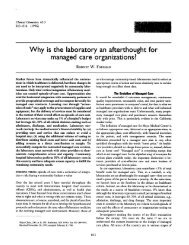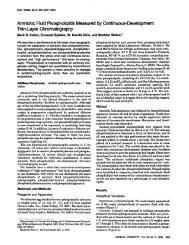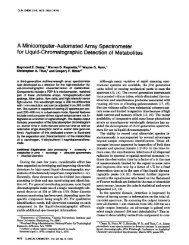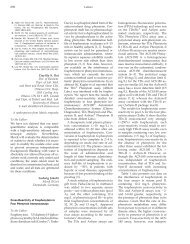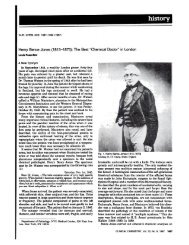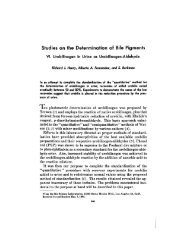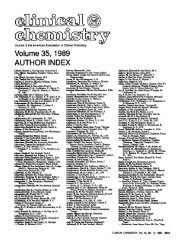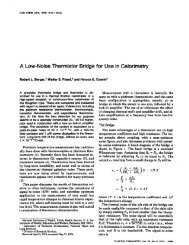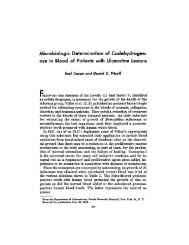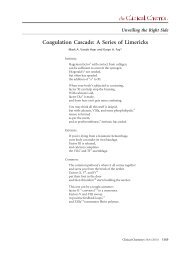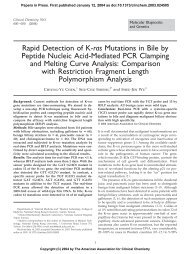Gas-Chromatographic Assay for Thiopental in ... - Clinical Chemistry
Gas-Chromatographic Assay for Thiopental in ... - Clinical Chemistry
Gas-Chromatographic Assay for Thiopental in ... - Clinical Chemistry
You also want an ePaper? Increase the reach of your titles
YUMPU automatically turns print PDFs into web optimized ePapers that Google loves.
CLIN.CHEM. 27/1, 113-115 (1981)<br />
<strong>Gas</strong>-<strong>Chromatographic</strong> <strong>Assay</strong> <strong>for</strong> <strong>Thiopental</strong> <strong>in</strong> Plasma, with Use of a<br />
Nitrogen-Specific Detector<br />
Donald Jung, Michael Mayersohn,’ and Donald Perrier<br />
An accurate, sensitive, and specific gas-liquid-chromatographic<br />
procedure is described <strong>for</strong> determ<strong>in</strong><strong>in</strong>g concentrations<br />
of thiopental <strong>in</strong> human plasma. After a double<br />
extraction of 0.2 or 1.0 mL of plasma conta<strong>in</strong><strong>in</strong>g phenobarbital<br />
as an <strong>in</strong>ternal standard, thiopental and the <strong>in</strong>ternal<br />
standard are derivatized <strong>in</strong> a polar non-aqueous solvent<br />
system with iodomethane. The reaction mixture is then<br />
evaporated, the residue reconstituted with ethyl acetate,<br />
and 20 tL <strong>in</strong>jected <strong>in</strong>to a 3% OV-17 column of a gas<br />
chromatograph equipped with a nitrogen-phosphorus<br />
detector. L<strong>in</strong>earity and reproducibility over the concentration<br />
range 25 tg/L to 10 mg/L <strong>in</strong> plasma are excellent.<br />
The sensitivity and wide range of l<strong>in</strong>earity exhibited by this<br />
method permit thorough characterization of the disposition<br />
of thiopental after the usual <strong>in</strong>duction doses of 3-4 mg/kg<br />
of body weight.<br />
Additional Keyphrases: barbiturates . drug assay<br />
anesthetics<br />
<strong>Thiopental</strong> [5-ethyl-5’-( 1 -methylbutyl) -2-thiobarbituric<br />
acidj is an ultra-short-act<strong>in</strong>g barbiturate used to <strong>in</strong>duce anesthesia<br />
<strong>in</strong> man and animals. Numerous methods of analysis<br />
<strong>for</strong> thiopental have been reported <strong>in</strong> the literature. Most lack<br />
the necessary specificity or sensitivity, or both, <strong>for</strong> completely<br />
describ<strong>in</strong>g the disposition k<strong>in</strong>etics of the drug <strong>in</strong> humans.<br />
Oroszlan and Maengwyn-Davies (1) ‘reported a nonspecific<br />
spectrophotometric assay <strong>in</strong>volv<strong>in</strong>g three different wavelengths<br />
and hav<strong>in</strong>g a sensitivity of 1 mg/L. A specific spectrophotofluorometric<br />
method (2) has a reported sensitivity<br />
of 0.1 mg/L and requires 3 mL of plasma. Several “high-per<strong>for</strong>mance”<br />
liquid-chromatographic assays <strong>for</strong> thiopental <strong>in</strong><br />
plasma have also been reported (3, 4). The sensitivity of these<br />
assays ranges between 0.1 and 1.0 mg/L. Numerous gas-liquid-chromatographic<br />
(GLC) procedures <strong>for</strong> barbiturates other<br />
than thiopental have been reported (5-9). A GLC method (10)<br />
with use of a flame ionization detector has a reported sensitivity<br />
of 0.2 mg/L, but we found it to be nonspecific <strong>for</strong> thiopental,<br />
ow<strong>in</strong>g to thepresence of an <strong>in</strong>terfer<strong>in</strong>g peak from the<br />
methylated oxy analog and metabolite of thiopental (pentobarbital).<br />
A specific and apparently sensitive assay was reported<br />
by Van Hamme and Ghoneim (11) to have a “low-end<br />
sensitivity” of
nobarbital per liter). The contents of the tube were vortexmixed<br />
<strong>for</strong> 15 s and centrifuged (3000 rpm, 5 mm). The organic<br />
(upper) phase was then transferred to a 15-mL test tube<br />
conta<strong>in</strong><strong>in</strong>g 1 mL of 2.5 mol/L NaOH. The solution was vortex-mixed<br />
<strong>for</strong> lOs, and centrifuged (3000 rpm, 1 mm), and the<br />
hexane layer aspirated. To the basic aqueous extract was<br />
added 4 mL of drug-free hexane and the solution was vortex-mixed,<br />
centrifuged, and aspirated as be<strong>for</strong>e. To the<br />
washed basic aqueous extract we added 1 mL of 3 molfL HCI<br />
and 4 mL of hexane. The contents of the tube were vortexmixed<br />
and centrifuged as be<strong>for</strong>e, and the organic layer was<br />
separated and evaporated under a stream of nitrogen at 60#{176}C<br />
<strong>in</strong> a Reacti-vial (Pierce Chemical Co., Rock<strong>for</strong>d, IL 61105).<br />
Methylation was per<strong>for</strong>med by add<strong>in</strong>g 500 zL of acetone,<br />
100 L of iodomethane, and about 5 mg of sodium carbonate<br />
to the dried hexane extract, then <strong>in</strong>cubat<strong>in</strong>g the mixture <strong>in</strong><br />
a vortex evaporator at 60 #{176}C <strong>for</strong> 30 mm. The supernate then<br />
was evaporated as be<strong>for</strong>e and reconstituted <strong>in</strong>to 20 L of ethyl<br />
acetate by vortex-mix<strong>in</strong>g; 2 tL was <strong>in</strong>jected <strong>in</strong>to the gaschromatographic<br />
column. Retention times <strong>for</strong> thiopental and<br />
phenoharbital are 1.7 and 1.3 mm, respectively. The standard<br />
curves were constructed by plott<strong>in</strong>g thiopental/phenobarbital<br />
peak height ratios vs thiopental concentrations.<br />
For standard curves <strong>for</strong> higher thiopental concentrations,<br />
200 L of plasma conta<strong>in</strong><strong>in</strong>g 0, 0.5, 1, 2.5, 5, and 10 mg of<br />
thiopental per liter was added to 200 tL of 1.5 mol/L NaH2-<br />
P04 and 200 zL of 2-propanol, and the mixture was extracted<br />
with 1 mL of hexane conta<strong>in</strong><strong>in</strong>g 8 mg of phenobarbital per<br />
liter. The extraction procedure at these higher plasma thiopental<br />
concentrations was per<strong>for</strong>med as <strong>for</strong> the lower concentrations,<br />
except that the basic aqueous extract was not<br />
washed with hexane. Methylation was done as be<strong>for</strong>e.<br />
Analytical<br />
Variables<br />
Reproducibility. The reproducibility of the method was<br />
determ<strong>in</strong>ed from results <strong>for</strong> repeated <strong>in</strong>jections. Concentrations<br />
of 50 and 500 g/L <strong>in</strong> plasma <strong>for</strong> the low-end standard<br />
curve and 1 and 10 mgfL <strong>for</strong> the high-end standard curve were<br />
prepared and each solution was <strong>in</strong>jected six times <strong>in</strong>to the<br />
chromatograph.<br />
Extraction efficiency. We determ<strong>in</strong>ed the efficiency of the<br />
extraction of thiopental from plasma by add<strong>in</strong>g known<br />
amounts of thiopental, equivalent to concentrations of 50 and<br />
500 g/L <strong>in</strong> plasma, to the hexane layers after extraction of<br />
drug-free plasma as previously described. The concentrations<br />
of thiopental <strong>in</strong> these samples were compared with the same<br />
concentrations of thiopental that had been added directly to<br />
plasma and extracted as previously described.<br />
Stability. Concentrations of 50 and 500 ig of thiopental per<br />
liter were prepared as described above, each <strong>in</strong> 10 mL of<br />
plasma. One-milliliter or 200-tL samples from each concentration<br />
were placed <strong>in</strong>to separate glass tubes and stored at -20<br />
#{176}C. Analyses were per<strong>for</strong>med once a week <strong>for</strong> eight weeks. On<br />
each day of analysis a standard curve <strong>in</strong> plasma was constructed<br />
and the thiopental concentrations of the stored<br />
samples were determ<strong>in</strong>ed by compar<strong>in</strong>g their thiopental/<br />
phenobarbital peak height ratios with those of the standard<br />
curve.<br />
Data<br />
Analysis<br />
With all standard curves, a straight-l<strong>in</strong>e fit of the data was<br />
per<strong>for</strong>med by least-squares l<strong>in</strong>ear regression analysis. All results<br />
are expressed as mean ± standard deviation (SD).<br />
Results and Discussion<br />
The use of a nitrogen-specific detector <strong>in</strong> analyses <strong>for</strong> barbiturates<br />
has been described by many workers. Such studies<br />
show that these compounds are not readily gas-chromatographed<br />
without prior derivatization, especially when nano-<br />
lS<br />
I IS I<br />
T<br />
HH1HI<br />
I I , I r I I , , I<br />
2 1 02 1 0 2 1 021 0<br />
A<br />
B<br />
C 0<br />
Fig. 1. <strong>Gas</strong>-chromatographictrac<strong>in</strong>gsobta<strong>in</strong>ed<strong>for</strong> human<br />
plasma<br />
A: Extractof1 mL ofdrug-free plasma with phenobarbital (IS) as <strong>in</strong>ternal Standard.<br />
B: Extractof 1 mL of plasma with 50 ig of thiopental (T) added perliter.<br />
C: Extract of 200 zL of drug-free plasma with phenobarbital (IS). D: Extract of<br />
200 iL of plasma supplemented with 500 .sg of thiopental (7) per liter<br />
gram amounts are <strong>in</strong>jected <strong>in</strong>to the columns. In addition,<br />
chromatography of the free drug does not take full advantage<br />
of the sensitivity of a nitrogen-phosphorus detector. When<br />
barbiturates are methylated by flash-heater methylat<strong>in</strong>g<br />
techniques with trimethylanil<strong>in</strong>ium hydroxide or tetramethylammonium<br />
hydroxide, the nitrogen detector detects<br />
large peaks <strong>in</strong> the chromatogram, caused by the derivatiz<strong>in</strong>g<br />
agents at the sensitivities required <strong>for</strong> the analysis. Dunges<br />
and Bergheim-Irps (13) reported a method <strong>in</strong> which an alkyl<br />
iodide and sodium carbonate <strong>in</strong> a polar nonaqueous solvent<br />
system were used to prepare the alkyl derivative. This procedure<br />
allowed better control of reaction conditions and<br />
avoided pyrolytic <strong>for</strong>mation of trialkylam<strong>in</strong>es, thus permitt<strong>in</strong>g<br />
measurement of thiopental concentrations <strong>in</strong> the microgram<br />
per liter range.<br />
Figure 1 depicts representative chromatograms <strong>for</strong> the high<br />
(500 g/L) and low (50 tg/L) concentrations. The methylated<br />
oxy analog of thiopental, N,N-dimethylpentoharbital, elutes<br />
with the solvent front <strong>in</strong> our system.<br />
The standard curves constructed <strong>for</strong> the peak height ratios<br />
of thiopental to <strong>in</strong>ternal standard were all l<strong>in</strong>ear and reproducible.<br />
Seven standard curves <strong>for</strong> thiopental <strong>in</strong> plasma with<br />
concentrations of 0, 25, 50, 100, 250, and 500 g/L at the low<br />
concentrations and 0, 0.5, 1, 2.5, 5, and 10 mg/L at the high<br />
concentrations were made at different times dur<strong>in</strong>g two weeks.<br />
The slopes of the plot of peak height ratio of thiopental to<br />
<strong>in</strong>ternal standard vs thiopental concentration <strong>in</strong> plasma <strong>for</strong><br />
the 42 po<strong>in</strong>ts at the low and high concentrations were 0.00585<br />
± 0.00021 L/g and 0.523 ± 0.013 L/mg, respectively. The<br />
coefficients of variation (CV) of the slopes were 3.6 and 2.5%,<br />
Is<br />
T<br />
IS<br />
114 CLINICAL CHEMISTRY, Vol. 27, No. 1, 1981
20<br />
I0<br />
5.<br />
11.I0.5<br />
here is necessary to characterize completelythe pharmacok<strong>in</strong>etics<br />
of thiopental after the usual 3-4 mg/kg <strong>in</strong>duction<br />
doses. An illustration of the latter application is shown <strong>in</strong><br />
Figure 2, a plot of thiopental serum concentrations as a<br />
function of time after the <strong>in</strong>travenous adm<strong>in</strong>istration of a 4.8<br />
mg/kg dose of thiopental sodium to one subject. The assay<br />
sensitivity permitted characterization of the concentrationtime<br />
course <strong>for</strong> two days; the data were best described by a<br />
triexponential function with a term<strong>in</strong>al elim<strong>in</strong>ation half-life<br />
of 8.6 h.<br />
Supported <strong>in</strong> part by a grant from the Office of the Provost <strong>for</strong><br />
Graduate Studies and Health Sciences, University of Arizona.<br />
0.1<br />
0.05<br />
N<br />
N,<br />
) 10 20 30 40 50<br />
Time,h<br />
Fig. 2. <strong>Thiopental</strong> concentration <strong>in</strong> serum as a function of time<br />
<strong>in</strong> a subject who received an <strong>in</strong>travenous thiopental sodium dose<br />
of 4.8 mg/kg.<br />
The solid l<strong>in</strong>e represents<br />
a non-l<strong>in</strong>earregression fit of the data<br />
and correlation coefficients of 0.98 and 0.99 were obta<strong>in</strong>ed <strong>for</strong><br />
the low-end and high-end standard curves, respectively. The<br />
correspond<strong>in</strong>g <strong>in</strong>tercepts were -0.090 (SD 0.049) tg/L and<br />
-0.168 (SD 0.062) mg/L.<br />
The CVs <strong>for</strong> thiopental <strong>in</strong> plasma <strong>for</strong> the low-end standard<br />
curve were 6.0% (51.7 ± 3.1 tg/L) and 3.9% (507.1 ± 19.8<br />
tg/L), respectively. At the high concentrations, the coefficients<br />
of variation <strong>for</strong> thiopental were 10.5% (1.05 ± 0.11<br />
mg/L) and 3.4% (10.14 ± 0.34 mg/L), respectively.<br />
Analytical recovery of thiopental from plasma averaged 89.9<br />
(SD 6.6)% and 82.8 (SD 2.2)% at 50 and 500 sg/L, respectively.<br />
No detectable deterioration <strong>in</strong> thiopental was observed over<br />
an eight-week study period. The 50 and 500 g/L solutions<br />
yielded concentrations of 49.9 (SD 4.6) tg/L and 497.5 (SD<br />
29.2) zg/L, respectively.<br />
Diazepam, fentanyl, and morph<strong>in</strong>e-drugs frequently used<br />
<strong>in</strong> conjunction with thiopental-were tested <strong>for</strong> potential<br />
<strong>in</strong>terference with the thiopental assay. These drugs are bases<br />
and are not extracted <strong>in</strong> our procedure, so, as expected, we saw<br />
no <strong>in</strong>terfer<strong>in</strong>g peaks at the retention times of thiopental or its<br />
<strong>in</strong>ternal standard, phenobarbital.<br />
Our method is more sensitive and specific than other published<br />
methods. The 25 tg/L sensitivity of the assay described<br />
References<br />
I. Oroszlan, S. I., and Maengwyn-Davies, G. D., Ultraviolet photometric<br />
assay of thiopental and pentobarbital <strong>in</strong> blood and plasma. J.<br />
Am. Pharm. Assoc., Sci. Ed. 49,507-509(1960).<br />
2. Dayton, P. G., Perel, J. M., Landrau, M. A., et al., The relationship<br />
between b<strong>in</strong>d<strong>in</strong>g of thiopental to plasma and its distribution <strong>in</strong>to<br />
adipose tissue <strong>in</strong> man, as measured by a spectrophotofluorimetric<br />
method. Riochem. Pharmacol. 16, 2321-2336 (1967).<br />
3. Blackman, C. L., and Jordan, C. J., Analysis of thiopentone <strong>in</strong><br />
plasma by high-per<strong>for</strong>mance liquidchromatography. J. Chromatogr.<br />
145, 492-495 (1978).<br />
4. Masoud, A. N., Scratchley,G. A., Stohs, S. J., and W<strong>in</strong>gard, D. W.,<br />
Simultaneous determ<strong>in</strong>ation of lidoca<strong>in</strong>e (lignoca<strong>in</strong>e) and thiopental<br />
<strong>in</strong> plasma us<strong>in</strong>g high pressure liquid chromatography. J. Liq. Chromat<br />
ogr. 1,607-616 (1978).<br />
5. Braddock, L. I., and Marec, N., <strong>Gas</strong> chromatographic analysis of<br />
submicrogram quantities of barbiturates us<strong>in</strong>g a flame ionization<br />
detector. J. <strong>Gas</strong> Chromatogr. 3,274-277 (1965).<br />
Ii. l)unges, W., Bergheim-Irps, E., Straub, H., and Kaiser, R. E.,<br />
Microtechniques <strong>for</strong> the gas chromatographic determ<strong>in</strong>ation of barbiturates<br />
<strong>in</strong> small blood samples. J. Chromatogr. l45, 265-274<br />
(1978).<br />
7. Greely, R. H., New approach to derivatization and gas-chromatographic<br />
analysis of barbiturates. (‘un. Chem. 20, 192-194 (1974).<br />
8. MacGee, J., Rapid identification and quantitative determ<strong>in</strong>ation<br />
of barbiturates and glutethimide <strong>in</strong> blood by gas-liquid chromatography.<br />
(‘ha. (‘hem. 17, 587-591 (1971).<br />
9. Fiereck, E. A., and Tietz, N. W., A gas-chromatographic method<br />
b>r separat<strong>in</strong>g and measur<strong>in</strong>g barbiturates and glutethimide <strong>in</strong> blood.<br />
(‘un. (‘hem. l7, 1024-1027 (1971).<br />
10. Becker, K. E., Jr., <strong>Gas</strong> chromatographic assay <strong>for</strong> free and total<br />
plasma levels of thiopental. Anesthesiology 45, 656-660 (1976).<br />
II. Van Hamme, M. J., and Ghoneim, M. M ., A sensitive gas chromatographic<br />
assay <strong>for</strong> thiopentone <strong>in</strong> plasma. Br. J. Anaesth. .50,<br />
143-145 (1978).<br />
12. Sennello,L. T., and Kohn, F. B., <strong>Gas</strong> chromatographic determ<strong>in</strong>ation<br />
of thiopental <strong>in</strong> plasma us<strong>in</strong>g an alkali flame ionization detector.<br />
Anal. Chem. 46, 752-755 (1974).<br />
13. Dunges, W., and Bergheim-Irps, E., A new methylation method<br />
<strong>for</strong> the gas chromatography of barbituric acids. Anal. Lett. 6, 185-195<br />
41973).<br />
CLINICALCHEMISTRY, Vol.27,No. 1,1981 115




